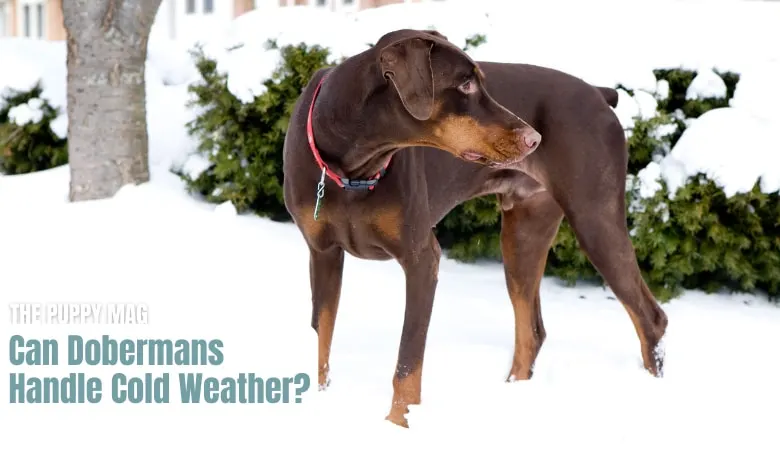Can Dobermans handle the cold winter weather? Although Dobies are a resilient breed, they don’t tolerate cold weather very well. This article covers frequently asked questions on this topic and provides valuable tips to keep your Doberman warm and safe in cold weather.

Table of Contents
Do Dobermans Get Cold Easily
Yes, Dobermans get cold easily. Although Dobermans technically have a double-coat, it’s not thick enough to keep them warm in cold weather. Extra caution should be taken when walking your Doberman throughout winter.
It turns out that the double-coat on a Doberman is fairly insubstantial and is mostly only found around the neck area. So, it’s not like a thick, prominent coat you would find on a husky, for example.
Why do Dobermans get cold?
1. Their coat:
Without a thick undercoat, your Dobie’s short semi-coarse outer coat isn’t enough to retain body heat and provides little protection against the outside elements.
2. Their origins:
If we look at the history of Dobermans, they don’t really have much exposure to cold weather. Originating in Germany, these hard-working dogs may have been outside from time to time, but there is no evidence of them being developed in cold regions.
How Cold Is Too Cold For a Doberman
So how cold is too cold? This is a great question and is frequently asked by owners.
It’s difficult to give an exact answer because it’s the weather condition that’s more important than the temperature itself.
This is because 5°C (40°F) on a sunny and still day is completely different from the same 5°C (40°F) on a windy and wet day. How cold it feels is more important than what the mercury reads, and that’s impacted by weather conditions.
To remain on the safe side, consider anything under 5°C (40°F) as potentially dangerous. On a sunny, dry, wind-fee day, your Doberman will likely be fine outside under these circumstances. But If the temperature is much lower than 5°C (40°F), or the conditions are not ideal to begin with, it’s safer to remain inside.

Psst. A quick update on Doberman training! Brain Training For Dogs could be the best training approach we’ve seen for Dobie pups. Results show improvement in obedience and behavior quicker than we thought possible! Check it out.
Do Dobermans Need Winter Jackets?
Yes, winter jackets are essential for any Dobie in cold weather. They provide an extra layer of protection, help him to remain dry, and retain body heat for longer.
If you don’t have one for your Dobie already, I really recommend getting one.
But, it does need to be said that winter jackets don’t automatically make your Doberman like Ironman. He’s still vulnerable, and caution does need to be taken. But in general, it will increase his tolerance and the duration that he can remain outside.
Our favorite winter coat is from Kurgo, it’s lightweight and comfortable without restricting movement. It’s water-resistant and you can get colors that are reflective (increasing his visibility in low light). Plus, it’s one of the most highly reviewed dog jackets on Amazon.
Trending: My Doberman Is Skinny!? Here’s Why
What Are Dobermans Most Vulnerable To In Cold Weather
There are a couple of conditions that all Dobie owners have to be aware of…
● Frostbite
● Hypothermia
These two conditions are both serious and all Dobermans are susceptible to them under the wrong circumstances.
⭐ Frostbite is when the skin and tissue become damaged and technically frozen through exposure to the cold. This can cause short and long-term damage. As you may already know, it’s the extremities that are the most vulnerable, so the paws, ears, nose, and tail. This is a treatable condition, but it can be painful and dangerous.
⭐ Hypothermia is more serious than frostbite and can be fatal. Hypothermia is when the major organs and cells in the body start to shut down. If hypothermia develops it can eventually stop the organs from working altogether. Hypothermia affects the heart, immune system, brain, and nervous system.
The danger of hypothermia is that it can happen gradually, making it hard to identify. Here are the signs:
● Slowing of movements and overall mobility
● Weakness and sudden fatigue
● Shallow and difficult breathing
● Dilated pupils
● Excessive shivering
8 Tips To Protect Your Doberman Throughout Winter
Let’s run through several tips that are essential to keep your Dobie as safe as possible as the temperature drops.
1. Use Paw Wax or Booties
The paws are extremely vulnerable as they are the point of contact to the ground. It’s not just the temperature that poses a threat, it’s the sharp rock salt and harsh ice-melt chemicals often used across driveways and paths.
Paw wax OR booties help by providing a protective barrier between the ground and their feet. Booties offer more protection but can be quite difficult to fit correctly.
Paw wax is an easier alternative but provides a little less overall protection. (our favorite option is listed below)
2. Use Nose Balm
Nose balm is pretty much the same as paw wax, and some products can even be used for the same purposes.
The nose is also vulnerable to frostbite, can dry out, become cracked, and very painful.
Nose balm coats the nose in a protective layer to combat the cold wind and freezing temperatures. Nose balm is very beneficial and is an absolute must. (our favorite option is listed below)
3. Use a Winter Coat/Jacket
Yep, I covered this already but it’s important to include it in this list. A winter coat will act as a valuable layer of insulation between your Dobie and the outside elements.
If you opt for a high-quality jacket then it will likely be somewhat water-resistant. Keeping your Dobie dry is vital when outside.
When he becomes wet, he’ll quickly become much more susceptible to frostbite and hypothermia.
4. Provide Lukewarm Drinking Water
You may want to do this before and after walks, or throughout the entire winter. By providing drinking water that isn’t straight from the cold tap (usually ice cold) it will keep him warm from the inside out.
Every house is different but mine sure does have awfully cold water from the cold tap in winter. Take the chill of his drinking water to help him remain warm.
5. Never Venture Too Far From Home
Dobies need a lot of exercise, and throughout summer you may have a set routine that involves hiking, running, or walking substantially far from your home.
In winter, always stay close by. And if your local dog park isn’t close, drive there first, then begin your walk after.
This is a precautionary measure as you never know when your Doberman might suddenly become too cold, or the weather suddenly turns. There’s nothing worse and more dangerous than being far away from home when the weather goes bad!
6. Don’t Spend Too Long Outside
Aside from sticking close by, keep the duration shorter than usual. Dobies typically need around 2 hours of exercise per day, if not more! But this doesn’t mean you should spend 2 hours outside in winter.
This would be quite dangerous. Depending on the temperature and weather conditions, the average walk during winter may only be 30-45 minutes at the absolute maximum.
You will need to use fair judgment on this one, but remember, in winter, keep outside exposure short.
7. Use An Extendable Leash
Depending on the day and the weather conditions, it may be preferable to keep your Dobie on the leash instead of letting him off.
The reason I mention this is because once you set a habit of going to the park, letting him off the leash for games of fetch, it’s easy to forget the differences that winter brings.
The low light and the sudden weather changes can make it difficult to call your Dobie back if he’s wandered off away from you. Sometimes, it’s much safer to keep him on the leash instead.
8. Avoid Lakes & Bodies of Water
If you exercise your Doberman where there is a lake, river, or body of water, extra caution should be taken.
Or even better, avoid that area altogether. I don’t know about your Dobie, but my friend’s absolutely loves swimming, and with or without her permission, swims in any pond available.
This is a massive hazard in winter as frozen lakes may not be properly frozen and ice-cold waters would almost instantly cause hypothermia. Not to mention the risk it poses for you if you had to go in after your Dobie!
Signs Your Doberman Is Getting Cold
Knowing the physical signs that indicate your Doberman is getting cold could be life-saving. Let’s run through the main indicators.
Signs your Doberman is getting too cold:
● Holding up a paw:
If you see your Dobie trying to hold any of his paws (usually the front) off the ground, this means he’s too cold. The paws are extremely sensitive to temperature and as the only point of contact, it’s often the first area that causes dogs problems.
● Slowing down or refusing to walk further:
Another indicator is when your Dobie starts slowing down. Whenever he stops bouncing and running around like a spring chicken, it’s a bad sign. Slowing down or refusing to walk is a sign he’s already very cold.
● Shaking and shivering:
Just like for us, shivering is an involuntary response from the muscles in order to create warmth within the body. It’s when the muscles start contracting and relaxing at a rapid pace in order to create heat. If you see your Dobie starting to shiver, it’s time to head back inside.
● Hunched over posture & tail tucking:
If you notice your Doberman to have his back in a hunched-over position this is another sign that he’s getting too cold. Usually, this is coupled with tail tucking, but many Dobermans have their tails docked so this will no longer be visible.
● Looks anxious or generally uncomfortable:
Overall body language is another very important thing to observe. How does your Dobie look? It helps to take a good look at his attitude, character, and energy at the start of the walk, and monitor how it changes as you progress. If he starts looking anxious, skittish, or generally nervous, he’s likely getting cold.
● Whining or whimpering:
Sometimes whining or whimpering may be very subtle and hard to hear, but it’s important to pay attention. If you’re well into your walk and you hear your Dobie making unusual noises that he wouldn’t normally make, it’s a clear sign that something is wrong. It very well could be the temperature.
If you see any of these signs, it’s very important that you make your way home or into warmth as soon as you can without any delay. This is also why it’s important to never venture too far from home.
Our Favorite Products:
⭐ Winter Jacket: Kurgo Reversible Weather Proof Jacket
⭐ Paw Wax: VetPro Complete Natural Paw Balm
⭐ Nose Balm: VetPro Complete Natural Paw Balm (for noses too)
⭐ Booties: ALLWIN Dog Waterproof Booties
Thank you for reading! I really hope your questions were answered on this topic! If I have missed something out you were expecting to see, please reach out to me. I am always happy to hear feedback and add in relevant sections.
